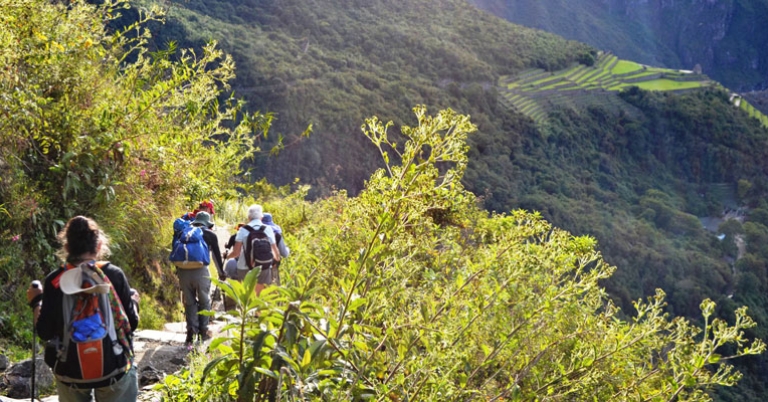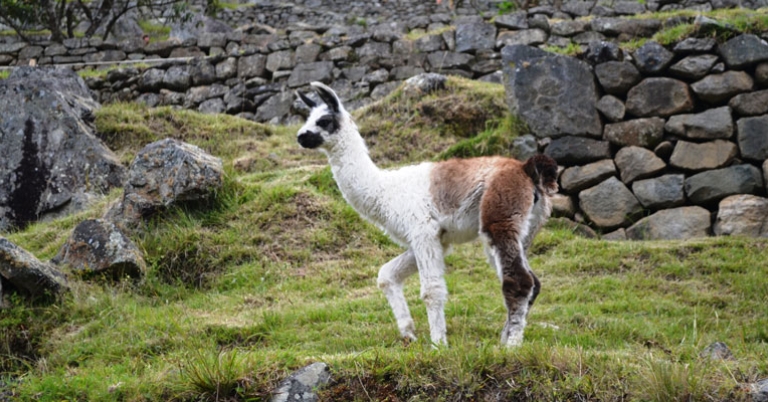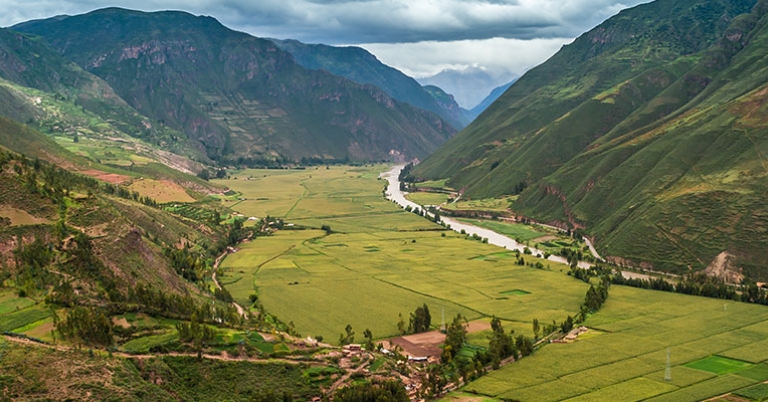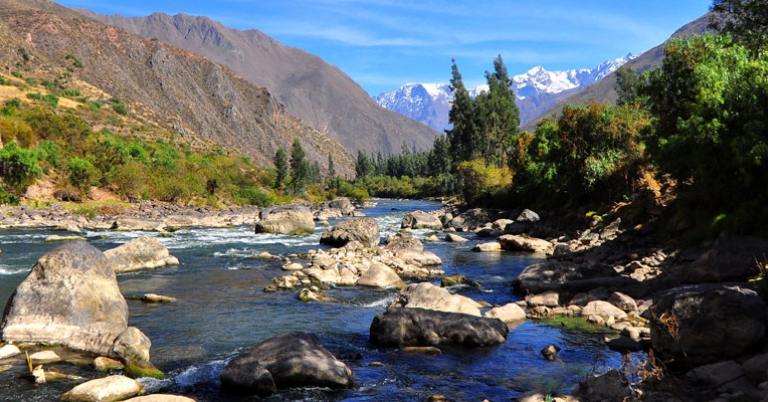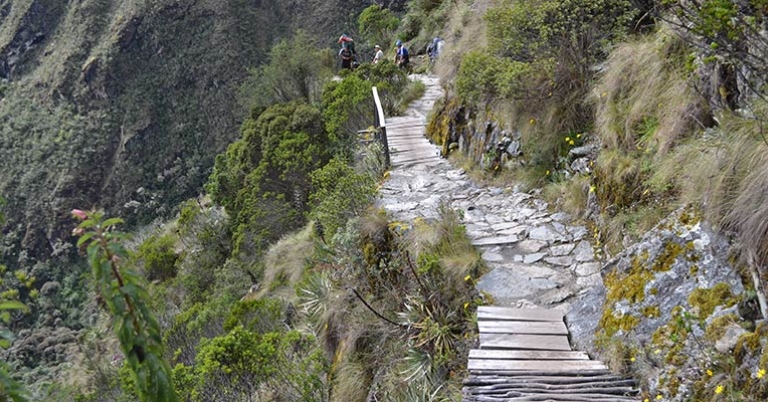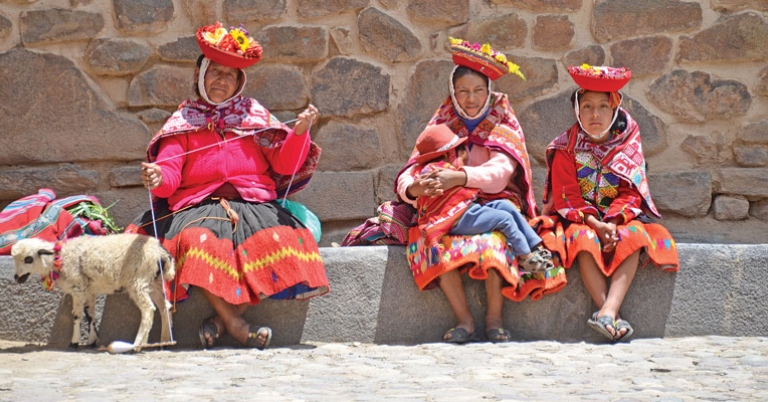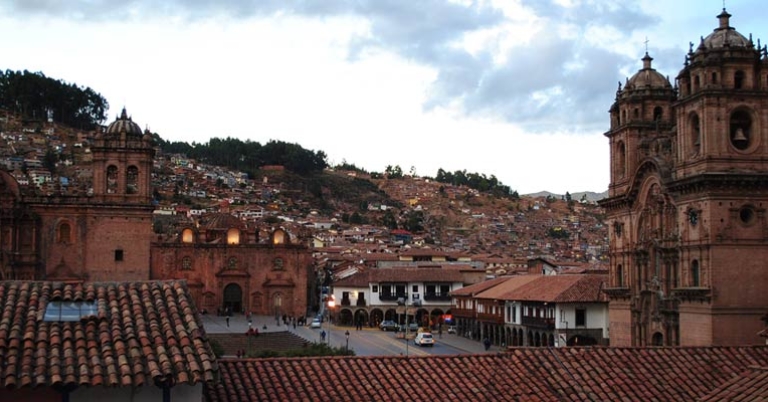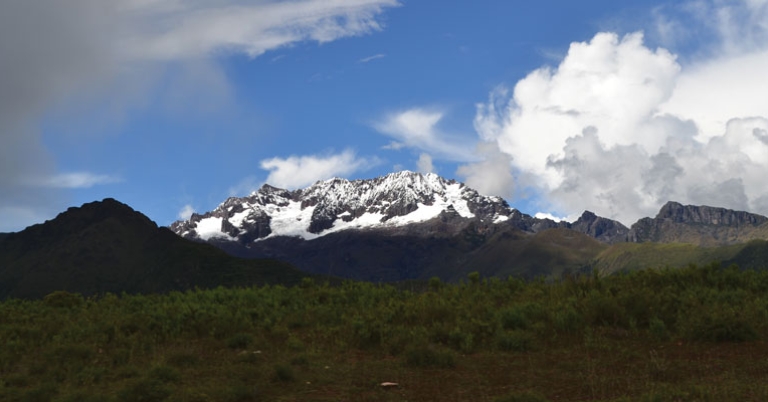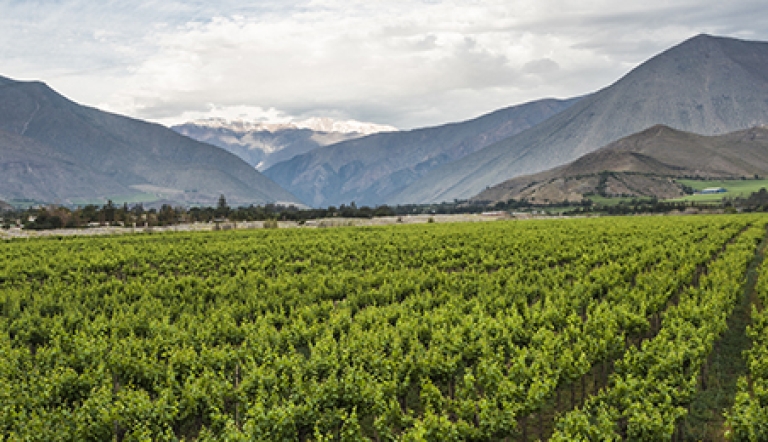Peru | Trekking the Inca Trail: Cusco to Machu Picchu
Date:
Activity Level:
Duration:
Price:
Interests:
About this trip
Follow in the footsteps of the ancient Inca on this active journey, perfect for families, friends, or independent travelers up for an adventure! Surrounded by towering Andean peaks, misty cloud forests, glacial valleys, and rushing streams, you’ll traverse Peru’s picturesque Sacred Valley on foot, capping off your multi-day trek at the breathtaking Machu Picchu citadel. At the end of each hiking day, enjoy freshly prepared meals and rest in comfortable camping accommodations in private, expedition-style tents. Learn from your local guides about the vast Inca Empire, the people who first forged these paths, and the modern-day descendants who carry on their legacy. The experience is complemented by exploration in the colonial gems of Lima and Cusco, both UNESCO World Heritage Sites. This program includes exquisite accommodations. In Cusco, Urubamba, and Aguas Calientes you’ll stay in the superb Inkaterra properties. As an example, the Machu Picchu Pueblo Hotel is located at the base of Machu Picchu and in addition to being a gorgeous hotel, it sits on 12 acres of pristine cloud forest for birding, orchid viewing, and other nature activities. Between the iconic hike of the Inca Trail and the outstanding hospitality of your local guides and accommodations, now is the time to embark on this bucket-list experience!
PLEASE NOTE: This Holbrook departure is not accompanied by a U.S. host. The group will be led by expert, English-speaking, local guides.
Highlights
- Embark on a 4-day trek on the historic Inca Trail, traveling approximately 26 miles on foot through the Sacred Valley of the Incas and culminating at the ruins of Machu Picchu.
- Visit sites of archaeological importance like Pisac, Patallaqta, Runkurakay, Sayacmarca, and Sacsayhuamán, with site lectures along the way.
- Enjoy the sumptuous hospitality at three Inkaterra properties in Cusco, Urubamba, and Aguas Calientes, including the world-famous Machu Picchu Pueblo Hotel.
- Stroll among the colorful textiles, jewelry, and other handicrafts at Pisac Market.
- Enjoy the option to hike to the summit of Wayna Picchu for amazing views of Machu Picchu below.
Important note: Permits
Permits are required to hike the Inca Trail. There are 500 permits allowed each day (including for support staff), and they are not guaranteed until purchased. Upon enrollment, you will be asked to submit a copy of your passport so that we may obtain a permit on your behalf. Holbrook will purchase permits once the group reaches minimum group size.
Activity Level 5: Strenuous
Participants should be able to ascend or descend 100 or more stairs consecutively, plus walk for at least 8 hours at high elevations over steep slopes, uneven, and potentially slippery surfaces without difficulty. Physical activities typically last for 5 or more hours at a time. Accommodations on the Inca Trail are tent camping, with porters accompanying the group to carry traveler luggage and supplies for meals and camping; travelers need only to carry their daypack.
$4,395
Per person
About this price
Land cost only. Does not include round-trip airfare to and from destination.
Single room supplement $750
What makes us different
Cultural Discovery
Low stress travel planning
Expert guides
Sustainable travel
Flight arrangements
Service anytime
Daily Itinerary
Print ItineraryLima
Lima
Urubamba
Urubamba
Inca Trail
Inca Trail
Inca Trail
Aguas Calientes
Cusco
Depart
Pricing
Print Pricing$4,395
Per person
About this price
Land cost only. Does not include round-trip airfare to and from destination.
Single room supplement $750
What's Included
What's Not Included
Pricing Details
A deposit of $350 is required for participants to register and reserve space on the program. Reservations submitted beyond the final payment deadline noted below will require full payment to enroll. 206 or more days before departure: $100 cancellation fee; remaining balance is refunded. 205 - 96 before departure: full deposits of $350 is forfeited. 95 - 0 days before departure: 100% of program price is forfeited.
Holbrook Travel strongly recommends the purchase of travel protection for medical emergencies while traveling and to protect your investment. Please note the purchase of Cancel for Any Reason Coverage or to exclude pre-existing conditions with Trip Cancellation coverage may require policy purchase within 10-14 days of your initial deposit, depending upon the provider.
Single room supplement $750
Final payment due date: February 19, 2026
Travel Info
Print Travel InfoEntry & Exit Requirements
U.S. citizens must have a valid passport to enter Peru. Passports must be valid for at least six months after the date of departure. Tourists must provide evidence of return or onwards travel.
For visits fewer than 90 days, you will be issued a tourist card, called the Tarjeta Andina de Migración (TAM), upon arrival in Peru. It is important not to lose this document, as it can be time consuming and inconvenient to replace.
If you are not traveling with a U.S. passport, please check with the Embassy of Peru for the requirements based on your nationality.
Requirements for Entry to the inca trail & Machu Picchu
To minimize stress on the Inca Trail and Machu Picchu archaeological site, access is strictly controlled and permits must be secured well in advance.
Holbrook will purchase tickets on your behalf. In order to do so, you will be asked to submit a copy of your passport following enrollment. If you need to apply for or renew your passport prior to traveling, we encourage you to do so as soon as possible.
Health Information
IMMUNIZATIONS
The Centers for Disease Control recommends that all travelers be up to date on routine vaccinations such as measles-mumps-rubella (MMR) vaccine, diphtheria-pertussis-tetanus vaccine, varicella (chicken pox) vaccine, and your yearly flu shot before every trip.
There are no vaccinations required for entry into Peru.
Though not required, the CDC recommends inoculation against hepatitis A, hepatitis B, and typhoid for most unvaccinated travelers to Peru.
In addition, yellow fever is a risk in certain parts of Peru, primarily east of the Andes at elevations below 7,500 feet. The CDC has recently updated its guidance to advise that travelers to Machu Picchu and Aguas Calientes may be at risk for yellow fever. (While the Machu Picchu complex itself is not an at-risk area, travelers must pass through affected areas to reach the site.) The CDC recommends the yellow fever vaccine if you are traveling to any of these areas.
Please consult your physician for additional information and recommendations based on your individual circumstances.
MALARIA
The CDC warns that malaria is a risk in certain parts of Peru, primarily east of the Andes at elevations below 6,500 feet. According to the CDC, malaria transmission is not known to occur in the areas around Lima, Cusco, Macchu Picchu and the Sacred Valley. If you plan to extend your program to visit other regions of Peru, please consult your physician to determine whether an anti-malarial drug is recommended.
DENGUE FEVER AND OTHER MOSQUITO-BORNE ILLNESSES
Dengue is common in Peru in the tropical and sub-tropical areas during the rainy season, especially in urban and suburban areas. Mosquitos that spread dengue do not usually live at elevations above 6,500 feet, so the risk of dengue in Cusco, the Sacred Valley, and Machu Picchu is low. Additionally, locally transmitted cases of chikungunya and Zika virus have previously been reported in Peru.
To protect against mosquitos, the CDC recommends that you cover exposed skin with lightweight, long-sleeved shirts and pants, consider treating clothes with permethrin, and use an insect repellent containing an EPA-registered active ingredient like DEET, picaridin, or oil of lemon eucalyptus (OLE). Apply sunscreen first, followed by the repellent, ideally 20 minutes later.
Be careful when applying products containing DEET, as it can damage or dissolve certain synthetic fabrics as well as plastic, rubber, vinyl, or elastic materials, such as those used in camera equipment, binoculars, phone cases, sunglasses, or watches. Additionally, some research suggests that when DEET and picaridin enter local waterways, they can be harmful to amphibians and other wildlife. When selecting a repellent, it is ultimately up to each traveler to weigh the risks and benefits of different options, keeping in mind both environmental factors and the importance of protecting against illness.
As a precaution, the CDC advises women who are pregnant to consider postponing travel to any area where Zika virus transmission is ongoing.
After spending time outdoors in grassy or wooded areas, the CDC recommends showering and conducting a full-body check for ticks. If you find a tick attached to your skin, safely remove it as soon as possible.
ALTITUDE SICKNESS
Upon arrival at locations of high elevation, shortness of breath and a pounding heart are normal responses to the lack of oxygen in the air. However, for some visitors, these symptoms can deteriorate into altitude sickness. Headache, extreme tiredness, dizziness, nausea, and loss of appetite are standard symptoms. Staying hydrated and well rested is important to adjust to the altitude. Avoiding heavy, fatty foods and alcohol in the days before arriving to altitude can help. Over-the-counter medications are also available to help prevent or alleviate symptoms. It’s advisable to avoid sleep medications, as they can slow breathing and respiration, which aid in getting the blood oxygenated while sleeping. Participants who take blood pressure medications should discuss this with their doctor as the medication can drop pressure too low at times.
SUN EXPOSURE
The effects of the sun can be damaging to the eyes and skin. Spending time outdoors exposes you to the sun’s harmful ultraviolet (UV) rays, even on cloudy days. To protect yourself from the sun, use a broad spectrum sunscreen of at least SPF 15, protect skin with clothing, wear a wide-brimmed hat and sunglasses, and drink plenty of fluids.
Respiratory Illness Protocols
Please review our Respiratory Illness Protocols page, which explains our policy and procedures if you or another traveler should develop symptoms of a respiratory illness during your trip. Your participation in a Holbrook Travel program indicates that you are in agreement with these protocols.
Resources
Print ResourcesSuggested Packing List
Everyone has personal preferences when it comes to packing; for this reason, the information below is offered as a general guide and not a definitive list. You know yourself best: Use your discretion and pack what you think will serve you, based on your personal preferences and specific itinerary.
Please keep in mind that each person is only allowed 4 kg (8.8 lbs) of personal luggage on the Inca Trail. Prior to the trip, you will be given a list of provided equipment not included in this allowance. On the train ride from Aguas Calientes back to Cusco, there is a luggage restriction for PeruRail of 1 backpack or carry-on weighing no more than 8 kg (17.64 lb). Excess luggage can be stored in Cusco.
You may find many of the items below at the New Headings Gear Store. Use code HolbrookGuest10 for a 10% discount on your purchase.
CLOTHING
Casual, comfortable hiking clothes, with layers for unpredictable weather, is recommended. From May to September, average low temperatures in Cusco are 32-39 °F; average highs are 66-68 °F. Clothing that wicks away moisture and dries quickly is recommended.
You may wish to bring a slightly nicer outfit or two for dinners out at Astrid & Gastón and Cicciolina Restaurant.
Bring enough clothing suitable for the length of your program. If you prefer to pack light, note that many hotels offer laundry services (at additional cost). If you plan to hand-wash items, remember that humidity may delay drying time.
- A combination of short-sleeved and long-sleeved shirts, suitable for layering
- Long pants, incuding hiking pants; shorts and/or skirts
- Undergarments
- Sleepwear
- Fleece or lightweight puffer jacket
- Bathing suit – Some hotels have pools.
- Socks – Bring extra pairs. Wool is recommended for hiking as it wicks moisture.
- Shoes – Hiking shoes/boots with good ankle support are strongly recommended. We advise well-worn and sturdy shoes with good tread (rubber soles are best). In addition, you may also want a pair of sturdy sport-strap sandals (e.g. Keens, Tevas, or similar) and/or casual flip-flops or sandals for around your hotel accommodations.
- Lightweight rain jacket, hooded poncho, and/or windbreaker – April to September is the dry season, but rain is still possible.
- Sun hat and/or beanie
- Bandana, scarf, or neck gaiter
- Lightweight gloves
Personal toiletries
Pack toiletries based on your personal preferences and habits. Below are just a few recommendations to keep in mind.
- Shampoo, conditioner, lotion, deodorant/antiperspirant, etc. – If possible, avoid strong fragrances if you are sensitive to insect bites.
- Soap and washcloth or a small, quick-drying microfiber towel – Washcloths are not standard in all hotels. If you normally use a washcloth, you may wish to bring one from home.
- Body wipes may be helpful on the trail.
- Hairbrush, comb, hair ties, shower cap
- Toothbrush and toothpaste
- Razor
- Ear plugs, especially if you are a light sleeper
- Personal hygiene products
- Insect repellent
- Sunscreen and lip balm with SPF – This is important at higher altitudes.
- A travel pack of tissues – also useful as napkins or toilet paper if needed
In addition to your personal toiletries, it is useful to pack a small medical kit, which you can easily prepare. Helpful items might include: bandages, antihistamine, a pain reliever, motion sickness and/or altitude sickness medication (if you are prone to either), anti-diarrhea medicine, powdered electrolyte packets to prevent dehydration, individually wrapped pre-moistened towelettes and/or hand sanitizer, antibiotic ointment, anti-fungal cream, moleskin for blisters, aloe vera gel for sunburn, eye drops, tweezers, a mini sewing kit, and an extra pair of disposable contact lenses or eyeglasses if you wear them.
MISCELLANEOUS
Remember to pack valuables such as your passport, cash/credit cards, and medications in your carry-on luggage.
- Passport and photocopies of all travel documentation
- Personal insurance card and travel insurance information
- Money – ATM/credit card and/or cash; small bills in good condition are recommended
- Prescription medicines (if applicable), with a copy of the prescription
- Sunglasses with strap
- Small day pack for the Inca Trail portion of your program
- Flashlight and/or head lamp
- Travel alarm clock or inexpensive waterproof wristwatch with alarm – Not all hotels provide alarm clocks.
- A pocket calculator or phone to assist with conversions and currency exchange
- Binoculars with lens cleaner
- Camera and related equipment, such as charger, lenses, and extra memory cards
- Reusable water bottle
- Non-perishable snacks
- Pocket-knife or multipurpose tool – Pack in your checked luggage.
- Zip-top style bags – useful for packing toiletries, sorting clothing, storing damp or muddy shoes, or as a dry bag for protecting electronics
- Notepad or travel journal and pen
- Music or reading material for down time, long bus drives, or on the airplane, and a portable bright light to read by
- Hiking poles or walking stick with rubber tip (folding or collapsible, for walking on rough and uneven terrain) – Pack in your checked luggage.
- A small quantity of laundry detergent if you’ll be washing clothing by hand
- Money belt
- Converter and adapter for electronics
- Chargers for electronics
- Dry bag for electronics
- Portable phone charger/power bank

Questions
Contact Lisa Palmese-Graubard at 800-451-7111 x339 or lisa@holbrooktravel.com.
